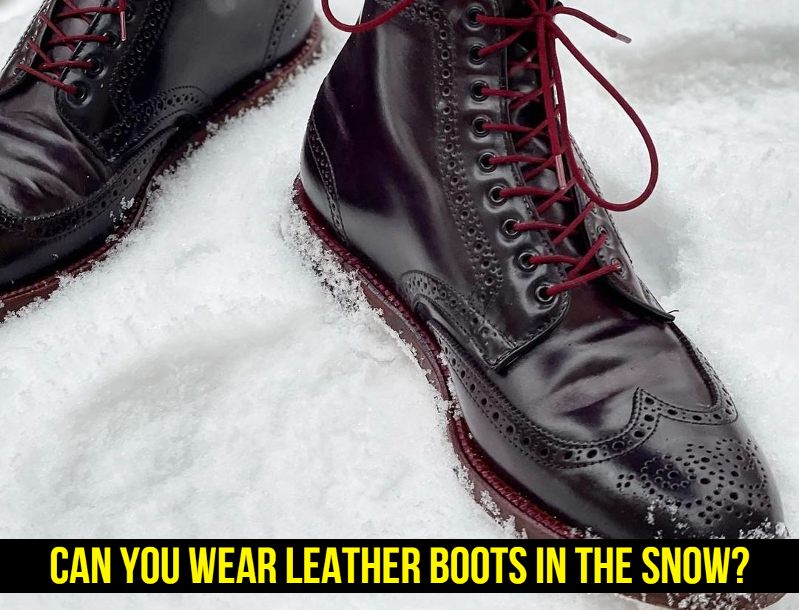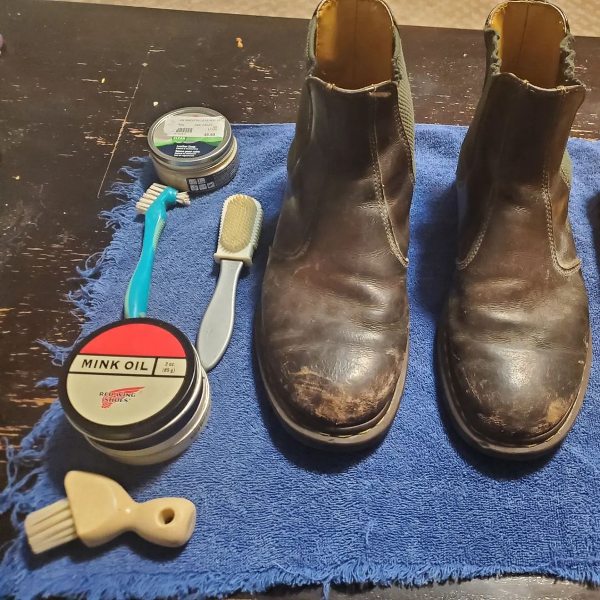Last Updated on August 1, 2024 by Sarah Jaffe

It was a cold winter day and the snow was falling gently to the ground. I had just gotten a new pair of leather boots and I was excited to wear them. I put them on and went outside, but within minutes my feet were cold and wet. I had to go back inside and change into my snow boots. I was disappointed, but I knew that leather boots and snow just don’t mix.
Is it safe to wear leather boots in the snow? Will snow damage the leather boots? Or, What can be done to safeguard leather boots from the elements during winter?
Whether you’re stomping through the city or taking a walk in the woods, a pair of leather boots is a winter staple. But what happens when you get caught in a sudden snowstorm? Can you still rock your leather boots or are you better off opting for a pair of snow boots? Here’s what you need to know about wearing leather boots in the snow.
Is it safe to wear leather boots in the snow?
Almost every individual prefers leather material for winter footwear because of its various properties. If we take care of the leather shoes and maintain them properly, they will last longer.
Leather’s breathability and insulating qualities make it an ideal material for boots. Leather retains heat while allowing moisture vapor to escape, so you don’t get too hot or too cold when you’re wearing them. Leather boots and shoes allow your feet to breathe while keeping some heat.
Layer up! Wearing two pairs of socks, a light inner layer, and a thicker outer layer will help keep you warm. You may also benefit from wearing waterproof gaiters, which will protect more of the boot from the elements.
When compared to other materials such as cotton or wool, leather is much less likely to absorb water and become saturated. Although rubber and synthetic textiles are both viable choices, if you want your feet to stay warm, it’s better to avoid these materials. If you wear rubber shoes in cold weather, your feet will sweat and then get wet and cold.
So, leather is really a fantastic material in many ways…but there’s more to the story.
What can be done to safeguard leather boots from the elements during winter?
1: Waterproofing
You need to prepare your work boots or heritage boots for the winter ahead of time, regardless of whether you’re wearing a pair of work boots or heritage boots. Thankfully, completing this task is simple and the process is not complicated.
To winterize leather, you must first apply an impervious or at least not very water-permeable sealant. The kind of dressing you’ll need to use depends on the material your boots are made out of.
Waterproofing treatments usually consist of wax or grease. For example, you might be scraping the market for a popular SnoSeal product or other boot greases on the market, such as Obenauf’s or Huberd’s.

What the finish does for leather is to create a fatty barrier, kind of like oil in a cast iron pan after cooking. The wax or grease creates a barrier between the leather and water, keeping the material dry.
2: Cleanliness is the key
To keep your boots safe and sound during the winter, clean them just before the rainy season begins and waterproof them. In general, it’s a good idea to clean your boots more often if you live in an area where people use de-icer on the roads and sidewalks.
As the De-icer can contain dirt, salt, and rock particles that can damage or degrade your boots over time. If you live in an area with mild or infrequent winter weather, this won’t be as big of a concern for you.
In order to effectively clean and shine your boots, use saddle soap. First, create a rich lather. Second, brush the outside of your boots with the suds. Finally, wipe away any remaining soap. Apply a light coat of your waterproofing treatment to the boots after you let them dry for an hour or two.
If you ensure to clean your boots and add a little oil or grease every few weeks, the leather will stay protected from any damage, and the boots will remain waterproof during winter. Leather boots are very good in the winter, provided that they’ve been correctly conditioned and treated.
Not only will your feet be warm and dry, but you’ll also look great.
3: Use of Tissues Or Newspaper
If you’ve just walked in the door after trekking about in your boots, stuffing them with tissues or newspaper to retain the moisture is a smart idea. However, don’t place them by the fire! Because of their high moisture content, they will dry out too rapidly and cause fractures. Instead, keep them in a cold and dry location until they’re able to retain their form.
4: Water & Vinegar Solutions On Salt Spots
Snow salt stains on leather boots can be removed with a ratio of equal parts water and white vinegar. To clean your boots with this mixture, simply soak a cloth in it and rub the fabric over the stain until it disappears.
5: Applying Mink Oil

Mink oil is effective on any sort of leather, as it penetrates deeply and does not leave a greasy residue. Test it on a small, hidden area first to check that the leather isn’t damaged by the solution. It’s also a great way to clean and soften the leather.
Simply rub mink oil onto your boots with a clean towel until it is completely absorbed. Allow the boots to dry for at least an hour before putting them on.
Will snow damage the leather boots?
The answer to that question is complicated and contingent on multiple factors, including the duration of your exposure to cold weather and whether or not your leather boots get wet. Ice will grow in the pores of leather as water penetrates it and freezes. As it refreezes, it becomes less solid, and this process is exacerbated when exposed to intense cold. It is a slower stride than fake leather since the petroleum product is less forgiving.
When you walk normally, the toes flex the leather near the point where they bend. The freezing of water, followed by a rapid fracture, will start to cut into the leather.
Plus when deciding whether or not to wear your leather boots in the snow, there are a few things to think about. If the snow is extremely wet, it may cause harm to the leather. Extreme cold weather can make leather rigid and more prone to developing cracks.
The weight of snow can stretch the leather, causing it to sag. It’s ultimately up to you whether or not you want to take the chance. If you do choose to wear your leather boots in the snow, be sure to care for them properly afterward.
Final Verdict
Winter weather can take a toll on leather boots. Leaving your boots untreated in the snow for too long can damage the leather due to exposure to moisture. Leather boots are a great investment, and if you take care of them, they can last for many years.
The best approach to keep your boots looking new is to waterproof them. To keep your boots in good condition, remember to clean them regularly and apply a light coat of oil or grease every few weeks. If you have any questions about how to care for your leather boots, feel free to ask in the comments below. Thanks for reading!
FAQs
Give your boots the best chance of survival by applying a protective barrier at the start and end of every season (as well as in between cleanings). Before you start walking in snow or salt, make sure to waterproof your boots with a preventative spray. It will save you time in the long run if you line all your boots up and do them all at once.
A waterproofing treatment is only necessary for leather materials that are especially vulnerable to staining or water damage. End users frequently apply waterproofing as an aerosol spray to restore the water-repellent qualities of their belongings.
Salt, snow, and sub-zero temperatures are not suited for most boots. If you want your boots to last through the winter, purchase a pair that is made for harsh weather conditions. Otherwise, you’ll risk causing harm to your normal boots and losing any warranties.

Sarah is the brains behind BootsNerd. Sarah Jaffe is a writer, editor, and boots lover based in Brooklyn, New York. She has done BA (Hons) in Footwear Design from De Montfort University, UK. She loves to write about boots and has a particular interest in vintage and sustainable fashion.